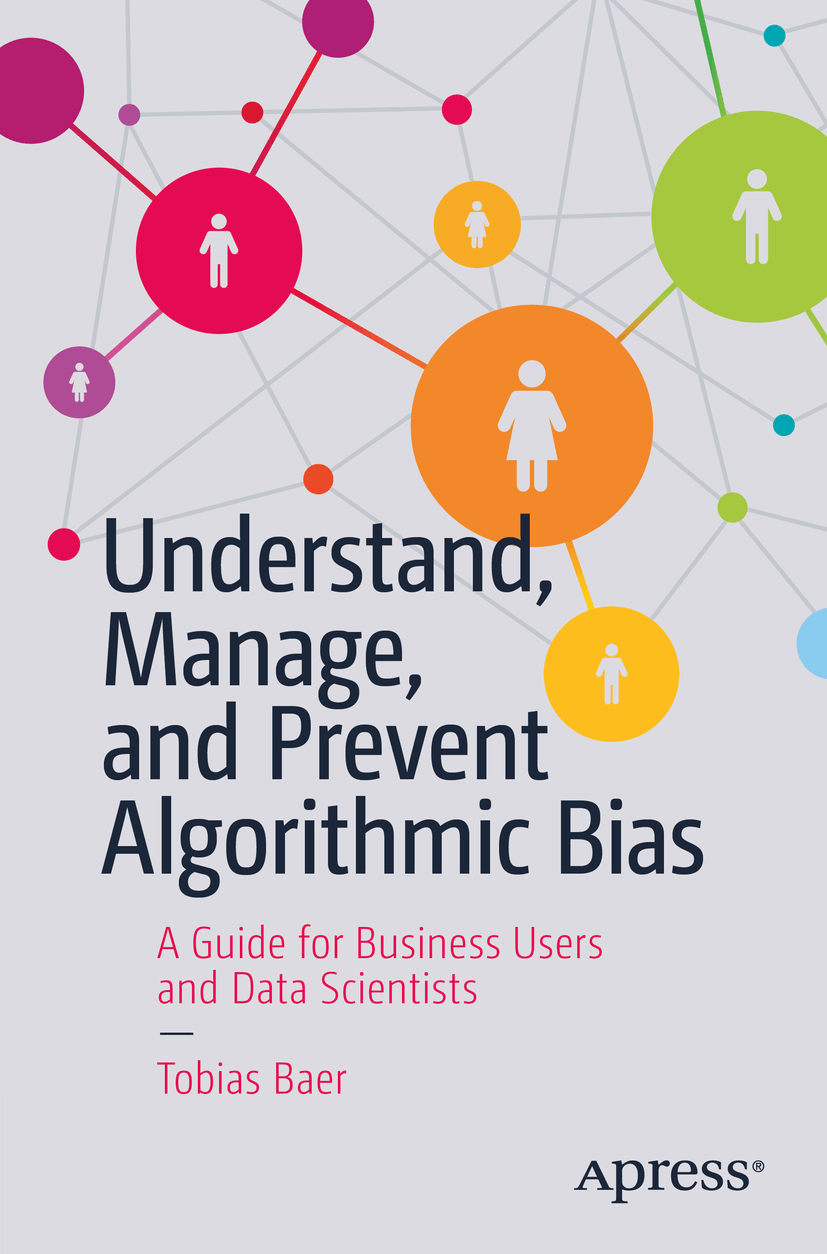Algorithmic bias can affect us everywhere, from minor trivia such as our social media feeds to critical decisions where bias can wreak havoc with a person's life dream or a company's survival. Often specific groups of individuals are affected – e.g., COMPAS, an algorithm US authorities use to estimate how likely a criminal will re-offend, has been found to exhibit racial bias; Google's algorithms for picking job ads have been found to favor lower-paying jobs for female users. However, companies can suffer from algorithmic bias as well – e.g., small businesses often struggle to get bank loans because the algorithms banks use to underwrite credit discriminate by size.
My new book is written for data scientists as much as for layman business users and argues that both sides need to join forces in order to manage and prevent algorithmic bias. Algorithmic bias actually has a wide range of sources – while some are driven by data and statistical artefacts, many have more psychological causes such as the data scientist's own biases, the behaviour of users, or deeply rooted societal biases. And many solutions to algorithmic bias can only be achieved through actions by the business managers and bureaucrats who commission algorithms, manage the processes that generate the data for the development of algorithms, or design the processes that deploy algorithm.
My book:
- Teaches the many sources of algorithmic bias (chapters 6-11) and shows both the holistic measures business users can use to manage and prevent bias (chapters 12-17) as well as the statistical techniques at the data scientist's hands (chapters 18-23)
- Provides practical, proven techniques to effectively combat and eliminate bias
- Addresses both basic statistical algorithms and advanced techniques such as machine learning and artificial intelligence
- Discusses the impact of bias on society and possible regulatory responses
It is often overlooked that algorithms can reduce or even eliminate bias from (otherwise human) decisions as much as add new biases. The book therefore examines algorithmic bias also in the context of designing an overall decision architecture that addresses both human and algorithmic biases; in the end the book is about making fairer, better decisions, and ridding the world of harmful biases. With this in mind, the book is written for business executives of companies using algorithms in daily operations; data scientists (from students to seasoned practitioners) developing algorithms; compliance officials concerned about algorithmic bias; politicians, journalists, and philosophers thinking about algorithmic bias in terms of its impact on society and possible regulatory responses; and consumers concerned about how they might be affected by algorithmic bias and what measures against bias they should push for as citizens.
Downloads
Would you like to have a peek into the book or download some of the tools I introduce for further use? Below you find a sample chapter to read - I've chosen chapter 4, which is a laymen-friendly introduction to the development process of algorithms but also, as I have been told, an excellent reference point for data scientists as it describes many ways for incorporating business insights into algorithms -, a fun chart with the "10 commandments for model development" that summarize some of the key recommendations to data scientists from my book, and the template for model documentation that I introduce in the book - it's written in a very engaging Question & Answer style that is an excellent tool for structuring and driving the data scientist's thought process as opposed to the usual frameworks for boring and painful post-modeling paper work! :)
Sample chapter to read: The Model Development Process (Ch. 4)
The 10 Commandments of Model Development
Model Documentation Template
My book's Table of Content:
Part I: An Introduction to Biases and Algorithms
Chapter 1: Introduction
Chapter 2: Bias in Human Decision-Making
Chapter 3: How Algorithms Debias Decisions
Chapter 4: The Model Development Process
Chapter 5: Machine Learning in a Nutshell
Part II: Where Does Algorithmic Bias Come From?
Chapter 6: How Real-World Biases Are Mirrored by Algorithms
Chapter 7: Data Scientists’ Biases
Chapter 8: How Data Can Introduce Biases
Chapter 9: The Stability Bias of Algorithms
Chapter 10: Biases Introduced by the Algorithm Itself
Chapter 11: Algorithmic Biases and Social Media
Part III: What to Do About Algorithmic Bias from a User Perspective
Chapter 12: Options for Decision-Making
Chapter 13: Assessing the Risk of Algorithmic Bias
Chapter 14: How to Use Algorithms Safely
Chapter 15: How to Detect Algorithmic Biases
Chapter 16: Managerial Strategies for Correcting Algorithmic Bias
Chapter 17: How to Generate Unbiased Data
Part IV: What to Do About Algorithmic Bias from a Data Scientist’s Perspective
Chapter 18: The Data Scientist’s Role in Overcoming Algorithmic Bias
Chapter 19: An X-Ray Exam of Your Data
Chapter 20: When to Use Machine Learning
Chapter 21: How to Marry Machine Learning with Traditional Methods
Chapter 22: How to Prevent Bias in Self-Improving Models
Chapter 23: How to Institutionalize Debiasing
Understanding, Managing, and Preventing Algorithmic Bias:A Guide for Business Users and Data Scientists
What did I learn by writing this book?
When I had started to develop statistical models over 25 years ago, I didn't even know the term "bias" - there seems to be no equivalent to "algorithmic bias" in the German language - but I was naturally concerned about the danger of a model systematically making wrong predictions and hence started to explore techniques to make my models ever more rebust. Without calling it this way, I was developing techniques to prevent algorithmic bias - such as thorough procedures during data intake to identify any kind of issue in the data that could introduce a bias. A pivotal moment was a stay at the Statistics Department of The Wharton School as a Visiting Scholar where I had the privilege of working one-on-one with Prof. Paul Shaman who taught me the foundations of what I call an "artisanal approach" of model development. I also had worked extensively on making "poor judgment" by humans better (e.g., in manual credit underwriting) many years before I delved into psychology and discovered that all along I had been fighting human biases (and just how rich the psychological effects behind decision bias are).
Only when I started to assemble the content for the book, I realized how much of my modeling "best practices" directly or indirectly served the purpsoe of preventing algorithmic bias - and how much interaction there was between biases in human judgment and algorithms. On the one hand, I had numerous times used algorithms as a tool to actually remove bias from previously judgmental decisions - but I also had faced numerous instances where algorithms had inherited biases from human decision makers. The book was like my entire professional and academic life (spanning psychology, statistics, data science, finance and risk management, as well as top management consulting) coming together in a comprehensive map of decision bias. I also realized how much of the work on preventing bias happened outside of data science - the generation and collection of data, the design of decision processes, and the design of business processes that determined the nature of interactions between users and algorithms. It was only then that I decided that writing a book for data scientists would not be enough and that I had to broaden the book to give specific, pragmatic guidance to business users as well in order to enable organizations to comprehensively and effectively manage and prevent algorithmic bias.
If you would like to hear more about some of the highlights of the book, watch the short video below (2½ minutes)!

